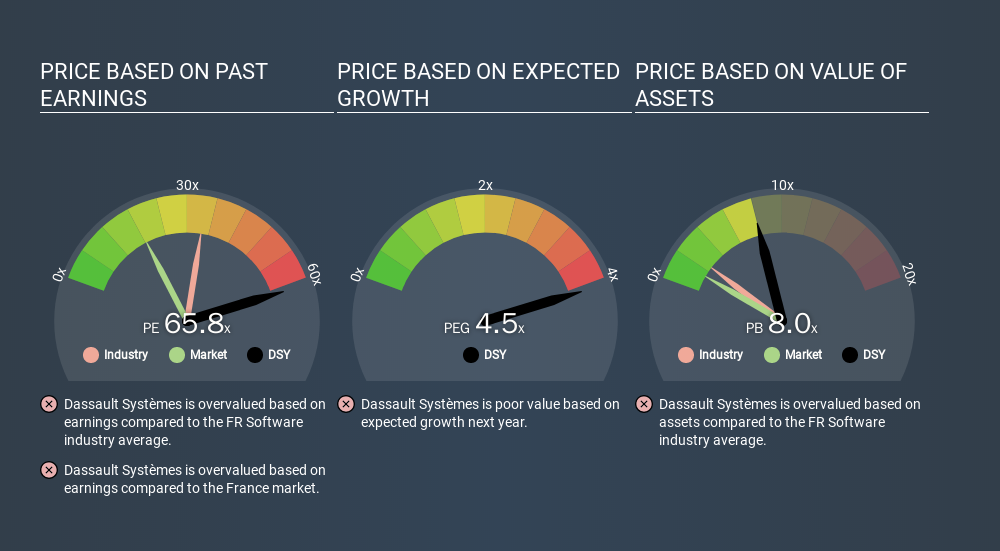Here's What Dassault Systèmes SE's (EPA:DSY) P/E Is Telling Us

Today, we'll introduce the concept of the P/E ratio for those who are learning about investing. We'll apply a basic P/E ratio analysis to Dassault Systèmes SE's (EPA:DSY), to help you decide if the stock is worth further research. What is Dassault Systèmes's P/E ratio? Well, based on the last twelve months it is 65.79. In other words, at today's prices, investors are paying €65.79 for every €1 in prior year profit.
See our latest analysis for Dassault Systèmes
How Do I Calculate Dassault Systèmes's Price To Earnings Ratio?
The formula for price to earnings is:
Price to Earnings Ratio = Price per Share ÷ Earnings per Share (EPS)
Or for Dassault Systèmes:
P/E of 65.79 = EUR158.35 ÷ EUR2.41 (Based on the year to September 2019.)
Is A High Price-to-Earnings Ratio Good?
A higher P/E ratio means that investors are paying a higher price for each EUR1 of company earnings. All else being equal, it's better to pay a low price -- but as Warren Buffett said, 'It's far better to buy a wonderful company at a fair price than a fair company at a wonderful price'.
Does Dassault Systèmes Have A Relatively High Or Low P/E For Its Industry?
The P/E ratio indicates whether the market has higher or lower expectations of a company. The image below shows that Dassault Systèmes has a higher P/E than the average (33.4) P/E for companies in the software industry.

Dassault Systèmes's P/E tells us that market participants think the company will perform better than its industry peers, going forward. Clearly the market expects growth, but it isn't guaranteed. So investors should delve deeper. I like to check if company insiders have been buying or selling.
How Growth Rates Impact P/E Ratios
P/E ratios primarily reflect market expectations around earnings growth rates. Earnings growth means that in the future the 'E' will be higher. Therefore, even if you pay a high multiple of earnings now, that multiple will become lower in the future. So while a stock may look expensive based on past earnings, it could be cheap based on future earnings.
Dassault Systèmes saw earnings per share improve by -8.6% last year. And it has bolstered its earnings per share by 15% per year over the last five years.
Don't Forget: The P/E Does Not Account For Debt or Bank Deposits
Don't forget that the P/E ratio considers market capitalization. So it won't reflect the advantage of cash, or disadvantage of debt. Theoretically, a business can improve its earnings (and produce a lower P/E in the future) by investing in growth. That means taking on debt (or spending its cash).
Spending on growth might be good or bad a few years later, but the point is that the P/E ratio does not account for the option (or lack thereof).
Is Debt Impacting Dassault Systèmes's P/E?
The extra options and safety that comes with Dassault Systèmes's €2.2b net cash position means that it deserves a higher P/E than it would if it had a lot of net debt.
The Verdict On Dassault Systèmes's P/E Ratio
With a P/E ratio of 65.8, Dassault Systèmes is expected to grow earnings very strongly in the years to come. Recent earnings growth wasn't bad. And the net cash position provides the company with multiple options. The high P/E suggests the market thinks further growth will come.
Investors have an opportunity when market expectations about a stock are wrong. As value investor Benjamin Graham famously said, 'In the short run, the market is a voting machine but in the long run, it is a weighing machine. So this free visualization of the analyst consensus on future earnings could help you make the right decision about whether to buy, sell, or hold.
Of course you might be able to find a better stock than Dassault Systèmes. So you may wish to see this free collection of other companies that have grown earnings strongly.
If you spot an error that warrants correction, please contact the editor at editorial-team@simplywallst.com. This article by Simply Wall St is general in nature. It does not constitute a recommendation to buy or sell any stock, and does not take account of your objectives, or your financial situation. Simply Wall St has no position in the stocks mentioned.
We aim to bring you long-term focused research analysis driven by fundamental data. Note that our analysis may not factor in the latest price-sensitive company announcements or qualitative material. Thank you for reading.
About ENXTPA:DSY
Flawless balance sheet with acceptable track record.
Similar Companies
Market Insights
Community Narratives



